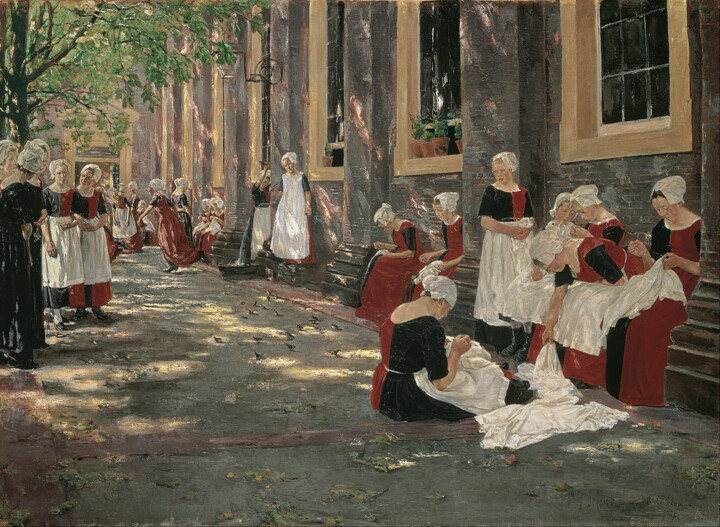


Période de liberté à l'orphelinat d'Amsterdam (1882) Painting by Max Liebermann
"Fine-Arts" prints on paper
It is a process of printing on art paper using very high-quality pigment inks and printed in very high definition. Its level of conservation is exceptional (more than 100 years), its quality, depth, and richness of nuances exceeds the classic photo print on Argentic paper.

Glossy finish
Apart from its exceptional thickness, the fiber paper is composed of an alpha-cellulose base without acid and it is covered with barium sulphate, and a microporous layer absorption enhancing pigments during printing. A pure white color, non-yellowing to light, this paper is especially designed for resistance and aging. It is used by major museums worldwide as it offers excellent resolution, rendering deep and dense colors.
Art Print "Fine Art" - Glossy finish on a fiber base paper 325 g.

Our high end prints and reproductions
ArtMajeur only uses natural papers with neutral pH, resistant, and of high quality, selected from renowned papermakers!
Constant attention is paid by our master printer, whether in terms of color control or respect for the graphic chain. Our high level of quality requirement is a major asset of ArtMajeur framed art prints.
For Artists! You help artists to live from their work. They receive royalties everytime you buy their prints.
About our fine prints-
Original Artwork
Painting,
Oil
on Canvas
- Dimensions Height 30.9in, Width 42.3in
- Framing This artwork is not framed
- Categories Impressionism Everyday Life
Certaines filles sont debout en groupes, semblant converser ou attendre leur tour, tandis que d'autres sont assises par terre ou sur les marches, absorbées par leur travail de couture ou de broderie. La lumière filtre à travers les feuilles d'arbres, créant des motifs d'ombre et de lumière sur le sol et donnant à la scène une atmosphère paisible et presque méditative.
Liebermann utilise des touches de pinceau délicates pour capturer les détails des vêtements et l'architecture environnante. La palette est principalement composée de tons terreux, avec des éclats de rouge plus vifs apportés par les robes, ce qui ajoute de la vie et de la couleur à la scène tranquille. Le tableau transmet une impression de quiétude, de structure et d'ordre dans la vie des orphelines, offrant un aperçu de la vie institutionnelle à cette époque.
Related themes
Max Liebermann was one of the most famous German Impressionist painters. He was born in Berlin on July 20, 1847. In 1873, he moved to Paris, where he studied with the French realist painter Jean-Francois Millet and the Dutch realist Frans Hals.
In 1884, he moved back to Berlin. In 1894, a new art group called "Berliner Sezession" chose him to be its first president. His art shows how art changed from the 19th century to the present day. Their work, along with that of Lovis Corinth and Max Slevogt, is a good example of German impressionism.
Max Liebermann died at home in Berlin on February 8, 1935.
-
Nationality:
GERMANY

- Date of birth : unknown date
- Artistic domains: Represented by a Gallery,
- Groups: Contemporary German Artists Artists presented by a gallery







